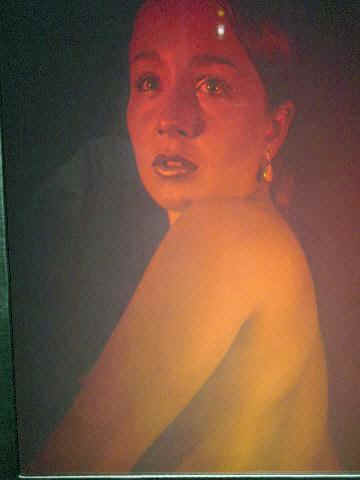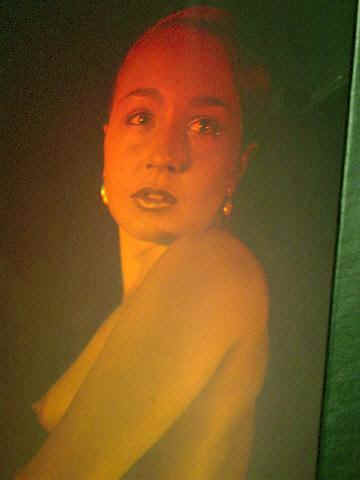Holographic Art: The Other Pearl
1. The Other Pearl, Number 1 in the Great Masters Series, a Tribute to Vermeer
2. Woman in a mirror, A tribute to Picasso
3. Two Majas Dyptic-A Tribute to Rubins
The Other Pearl, Number 1 in the Great Masters Series,
a
Tribute to Vermeer


Two different photographic images from "The Other Pearl"
Holograph on Glass, 14"X20"
by James Trolinger
Produced at Laser Reflections in San Francisco under the technical supervision of Bernadette and Ron Olson..
Limited edition of 300
Artist’s Description
The "Other Pearl" is the first in a series of limited edition holography studies based on the ideas and works of great masters in art. Even before photography was invented, artists used various photography-related devices to help with their work. This series honors the masters by exploiting and imitating their fundamental ideas and suggesting how their masterpieces may have appeared if holography had been a tool at their disposal. The "Other Pearl" is based on work of the fifteenth century Dutch painter, Jan Vermeer, by borrowing from his "Girl with a Pearl Ear ring".
I have chosen Vermeer as the first because of his mastery of light. He developed techniques to bath his subject with light and especially highlights that were matched by no one. As described by two well-known critics, "Vermeer was master of pictorial light and so comprehended its functions as to place it completely in the service of the artist’s intention, which is to render a lighted depth so faithfully that the picture surface is but an invisible glass through which we look immediately into the constructed illusion." This description easily could characterize Vermeer, himself, as a holographer. The recent discovery by Hockney that Vermeer was one of the Masters who traced his images by using optical devices is yet another reason for choosing his work.
Vermeer's "Girl with a Pearl Earring" is considered by many to be the Dutch "Mona Lisa". She has been described as "ravishing", as "pure beauty", and "the ultimate innocence". Her eyes sparkle, and her look of vulnerable innocence has never been captured so perfectly by any other artist. Even so, one's glance is drawn to the bright highlight from a (pearl?) earring on her left ear. Upon closer examination, one must ask if the earring really is a pearl. A much larger, oval-shaped, and dark earring that really does not appear to be a pearl surrounds the glint, which from a distance looks like a pearl. Maybe it is a black pearl or some other material referred to as pearl. Much is left unseen.
If only we could see the other earring; Vermeer's composition hides it from view. He could not have captured the same glance with a different composition. (Only Picasso, and the cubists would attempt that.). One can move closer to the painting, but the aging and cracking paint mask, rather than reveal, more information about what Vermeer really meant. Most of his paintings are populated with still life symbols, elaborate pictures, furniture, draperies, and windows. However, this painting features the girl and the "pearl" placed in a dark, empty background, with only her heavy clothing and scarf-covered hair to distract.
The objective here is to explore, not duplicate, Vermeer's work and to exploit the medium of holography with a modern vocabulary. A similar composition was chosen with the added feature that (with holography) moving ones viewpoint provides additional useful information. What we intend to convey is the value of different perspectives (and more information) in life. In modern times our perspectives can at least access more information, and hopefully, more truth. The hologram contains many compositions within its field of view. Vermeer’s shape and positioning of the earring is maintained, but we replaced them with stones to provide a sparkling source with every movement, however small, of the viewer, thus adding a time varying element to the experience of viewing. A close look reveals colors in the reflections, confirming that stones are present because refraction and dispersion are observed. While the hologram lacks in full color, its ability to manipulate light directly in such a manner provides optical brightness and activity only to be matched by the real object itself.
Because the view changes with viewing angle, the viewer becomes a part of the subject of the study, a participant of sorts in overlapping evolving present time with frozen past time, a participant in our special salute from the twenty first century to the ingenious talent of Vermeer. Overlapping two different time dimensions in this way is a feature of this medium that is not attainable with painting or photography.
Perhaps the most obvious and striking new feature is the ability by moving ones viewpoint to the left side of the hologram to reveal the other earring! Wesuggest the importance of looking at many perspectives in life before making conclusions.
Vermeer could paint his model with whatever discretion he desired. Did he change her appearance from the real world? Did he choose to remove a freckle or pimple? We have no way of knowing how close Vermeer's painting resembles the real girl, or how much of her came from his imagination. He could change the truth easier than we can with holography. We attempted to convey the same innocence and pure beauty, and we cannot change the truth, or airbrush away blemishes the way photographers do. Therefore, we chose not to compete with Vermeer's imagination or his skill. In 300 years the viewer will know exactly how our actual model appeared to us, offering a certain honesty and innocence to our work that cannot be attained in any other way.
Vermeer did no nude paintings. Southern Europeans put nudes in their work according to strict rules. A nude was acceptable as long as it represented a classical God or Goddess. If you wanted a nude painting it had to represent Venus or the Rape of the Sabines and so on, set in a classical setting. The Dutch religion of the day discouraged use of nude subjects. Vermeer's "Girl" is heavily clothed; even her hair is covered. We do one more thing that Vermeer could not; we unclothe the girl and provide the viewer with yet more information. For this artist she does not need to represent a Goddess or anything other than what she is, a young 21st Century woman from San Francisco with dreams, ambitions, and fears like most of her generation, which show in the sparkle of her eyes.
I have painted companion portraits to the hologram that capture some of the many thousands of different views that can be seen in the hologram. My paintings allowed me to freeze the model in time and to study her from all angles as she posed in that instant. I used the model, photographs, and the hologram to help create the paintings. In this way, my painting would be different from Vermeer's because his was taken from an evolving subject; mine came from a subject for which time had been frozen. Our subject was caught in a window into the past, namely, the holograph of her.
Here is one of the paintings.
Amanda 1-15"x22", watercolor on paper, painted from a hologram
Woman in a Mirror; a tribute to Picasso
Number 2 in the Great Masters Series
Hologram on Glass, 18"X24"
by James D. Trolinger, artist, and Ron Olsen, holographer. Limited edition of 300
Would Picasso have used holography if it had been available to him? With his resources cost would not have been an issue. And a world of easy innovation would have been available to him. Picasso invented cubism to achieve many perspectives in a single flat canvas, placing them contiguously, resulting in an image that requires considerable study to relate them to his subject. Two thousand years ago Egyptians did something similar in placing a profile and a front view together.
Holography captures many perspectives, all realistic, and yet still using only a two dimensional "canvas". The viewer must study the hologram, moving his head about to see different perspectives, but he is never in doubt about what he is looking at.
The mirror allowed Picasso to show a second dimension of perspectives in his "Woman in a Mirror". The woman in the mirror, in fact, does not even resemble the one facing the mirror. If anything it looks more like a man. A mirror is even more powerful when used with holography, even though it cannot lie or deceive, as Piccaso's mirror does......or can it? Holography shows us that perspective is everything when the search for truth is the objective.
Our model can be seen first as a gestural subject, a series of lines that represent the energy in her body. Tnen looking beyond the surface is the actual young lady standing before a mirror. From one perspective her body blocks the mirror and we cannot see the front of her body. From another, the front of her body comes into clear view. In her modesty she blocks our view of some parts of her body in a way that denies that perspective even to holography.
Mirrors have been used in paintings for over 500 years with artists going, some times, to great lengths to put detail in the reflected image. Our mirror can be searched from many perspectives to find many secrets.
Two Majas Dyptic-A Tribute to Goya
Oil on Hologram on Glass
Goya's Majas hang in the Prado in Madrid, one the Naked Maja and the other the Dressed Maja. Much debate has surrounded these two paintings. Most critics believe that the dressed Maya is the best of the two paintings. The face on the painting is believed to be that of a different lady than the body, who was a member of royalty with whom Goya was having an affair. Would Goya have used holography to incorporate both compositions in the same painting?
In honor of Goya I have created a hologram that allows the viewer to undress the Maya simply by moving his head slightly to the left.
